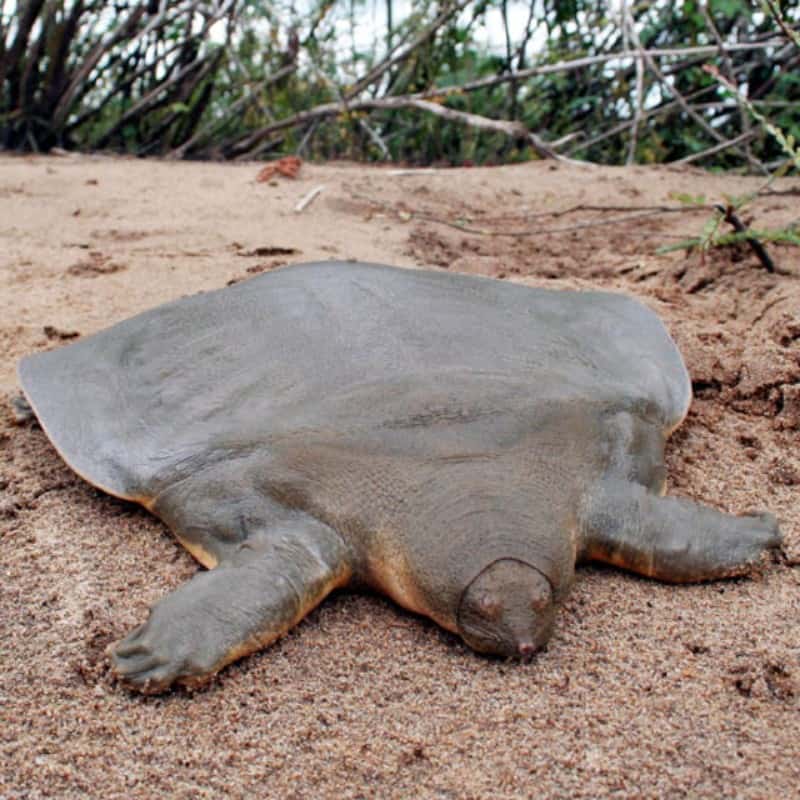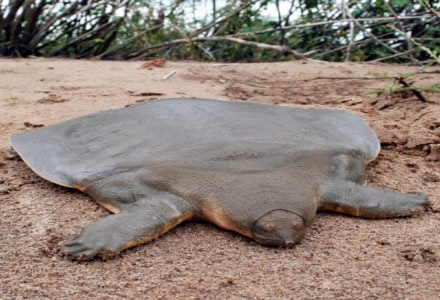
Cantor’s Giant Softshell Turtle Facts
- This impressive, not to mention distinctive, creature most frequently goes by the informative common name of the Cantor’s Giant Softshell Turtle. It also goes by several other alternate names, though, much like many species or reptile around the world.
- Its two other generally accepted common names, however, remain just as descriptive and informative as the primary one. These less frequently used, but still applicable, terms consist of the Asian giant softshell turtle and frog-faced softshell turtle.
- Scientific professionals, such as researchers, meanwhile, generally refer to the animal by its formal scientific name. That, though, is the somewhat tongue-twisting name of the Pelochelys cantorii. By any of these terms, it represents an amazing species.
- The first recorded formal recognition of the creature as a separate and distinct species, furthermore, took place in the year 1864. The respected British zoologist, John Edward Gray made that noteworthy contribution to the annals of science.
- Regrettably, the population of the Cantor’s Giant Softshell Turtle appears to be in decline. For that reason, the IUCN lists the species as Endangered, on its Red List. The primary threats to its existence seem to consist of habitat loss and hunting.
Related Species
Olive Ridley Sea Turtle Green Sea Turtle Pinta Island Tortoise
Photographer: Brown R Siler
CC License: https://bit.ly/31RL9iJ
Cantor’s Giant Softshell Turtle Physical Description
The amazing Cantor’s Giant Softhsell Turtle easily impresses those fortunate enough to encounter it. It does so, however, due to more factors that simply its size. That characteristic nonetheless remains its most noteworthy attribute, in the minds of most people.
The animal also displays a degree of the physiological characteristic of sexual dimorphism. The degree to which this trait develops, however, remains extremely minor. It’s reflected in the nature of the tail. That of the male develops as thicker than the females’.
In terms of simple overall size, though, both genders attain virtually the same average measurements. The carapace typically averages between 28 – 39 in (71 – 99 cm). Individuals also reach an average weight of approximately 220 lb (100 kg), though exceptions occur.
The carapace itself also has a relatively smooth texture, with this typically presenting an olive green color. Yet immature individuals often display dark mottling and yellow coloring. This characteristic appears primarily present around the edges of the carapace.
The amazing Cantor’s Giant Softshell Turtle also has a broad skull, with relatively small eyes. These appear located close to the tip of the snout. When it reproduces, the female typically lays between 20-28 eggs at a time, between the months of February and March.
- Kingdom: Animalia
- Phylum: Chordata
- Class: Reptilia
- Order: Testudines
- Family: Trionychidae
- Genus: Pelochelys
- Species: P. cantorii
Cantor’s Giant Softshell Turtle Distribution, Habitat, and Ecology
Unfortunately, the fabulous cantor’s Giant Softshell Turtle evolved as native to a restricted region of the world. Even more regrettably, that zone’s now been reduced even more. Currently, it appears in only a few select sections of the contiinent and region of Asia.
The amazingly evolved reptile now primarily occurs only in the countries of India, Burma, and Thailand. Individuals do also occasionally appear in Cambodia, Vietnam, China, and Java. On occasion, individuals even appear in neighboring areas as well.
It remains undetermined if these are indigenous to these areas, however, leading to even more confusion. The remarkable reptile lives almost exclusively in freshwater streams and rivers. These bodies of water must also be relatively slow moving.
Although populations of this species most often live inland, there presently remains some evidence that its range also includes coastal regions as well. Ongoing investigations, however, continue to attempt clarify this situation, to better understand the creature.
The primarily carnivorous Cantor’s Giant Softshell Turtle also seems to be a highly effective ambush predator. It feeds primarily on mollusks, fish, and small crustaceans. Specimens occasionally will also consume small quantities of various aquatic plants.
Species Sharing Its Range
Golden Pheasant Chinese Lantern Indian Bullfrog
Check out our other articles on Mexican Mole Lizard, Tuatara, Kemps Ridley Sea Turtle, Green Sea Turtle, Helmcken Falls, 5 Amazing Andean Species, 6 Laudably Luscious Lilies

